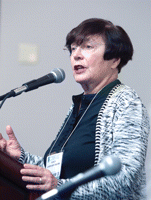What's Going On in Brains of Creative People?
Abstract
What is creativity?
This question has long fascinated Nancy Andreasen, M.D., Ph.D., the Andrew H. Woods Chair of Psychiatry at the University of Iowa, she acknowledged at the APA annual meeting in Honolulu in May. Andreasen obtained a doctorate in English literature before becoming a psychiatrist. Moreover, she has conducted studies on the subject of creativity since becoming a psychiatrist.

Nancy Andreasen, M.D., Ph.D.: "I think most mentally ill creative people are grateful to be treated with medications if the medications improve their lives."
Creativity, Andreasen believes, is "the ability to perceive or produce novel ideas or products that are useful to society." And it seems to start, she said, by a person plunging into a state of deep concentration, of dissociation. She once interviewed the American playwright Neil Simon, and he reported that he goes into a dissociative-like state when he creates his plays.
Once people descend into that state of dissociation, they then probably experience heightened activity in the association cortices of the brain, such as certain frontal regions and inferior temporal regions, Andreasen reported. She came to this conclusion after conducting a brain-imaging study of people in a resting state that showed that the association cortices of their brains were especially active at this time. Further evidence, she suggested, comes from a study she and her colleagues conducted that used neuroimaging to examine the brains of highly creative artists and scientists and of a group of not-so-creative subjects during an experimental task (a word-association task). That study indicated a lot more activity in the association cortices of the former group than in the latter.
Once the association cortices are activated, Andreasen is not sure what happens next in the creative process. But the cortices probably send messages back and forth to each other and produce new ideas, she conjectured.
The reason why certain people tend to be more creative than others is not due to I.Q., Andreasen pointed out. Many years ago, a Stanford University scientist conducted a landmark longitudinal study in which he followed high-I.Q. subjects at 10-year intervals. He found that while the subjects tended to possess numerous positive attributes—for example, good marriages, good income, and good mental health—"they did not actually make creative contributions." Yet brain characteristics other than intelligence level explain why certain people are especially creative, she said. For example, creative people may have larger right brain hemispheres than noncreative people, and creative people are often ambidextrous or left-handed.
Indeed, a number of people with mental illness are also ambidextrous or left-handed (Psychiatric News, March 20, 2009), which raises this question: If both creative people and people with mental illness more often tend to be ambidextrous or left-handed, are creative people also more often mentally ill?
The answer may be yes, Andreasen said. For example, she once recruited 30 well-known writers from the Iowa Writers' Workshop and 30 control subjects (hospital administrators) and compared mood disorders among the writers and their relatives with mood disorders among the control subjects and their relatives. She found far more instances of mood disorders in the writers and their relatives than in the control subjects and theirs.
Anecdotal evidence also links creativity with schizophrenia, she pointed out. For example, the English mathematician and philosopher Bertrand Russell had many family members with schizophrenia. The English mathematician Isaac Newton was chronically suspicious and had a psychotic breakdown. Physicist Albert Einstein "clearly had schizotypal traits. He was aloof and cold and had a son with schizophrenia." The co-discoverer of the structure of DNA, James Watson, has a son with schizophrenia. And then there is the Nobel Prize-winning mathematician John Nash, Ph.D., who has schizophrenia and a son who suffers from the illness as well (Psychiatric News, July 6, 2007).
The link between creativity and mental illness should not be surprising, since both offer new or unique views of the world, Andreasen noted. Or as Nash once said, "The ideas I had about supernatural beings came to me the same way my mathematical ideas did. So I took them seriously."
So, just as some people who are creative tend to be a little different, so are some people who are mentally ill. And they may often be one and the same, Andreasen said. And this conclusion, she added, raises an important question: Could treating creative, mentally ill individuals with psychotropic medications stifle their creativity? Not necessarily, she replied. For instance, the American poet Robert Lowell continued to write great poetry after receiving lithium for his bipolar disorder and was grateful to have a treatment that seemed to be a miraculous cure after years of suffering. "I think most mentally ill creative people are grateful to be treated with medications if the medications improve their lives," Andreasen declared.



